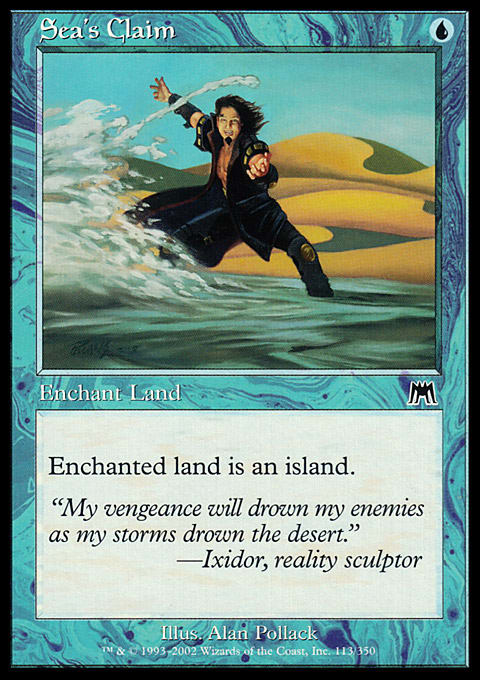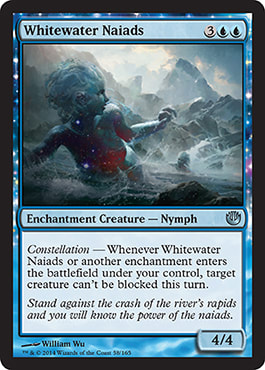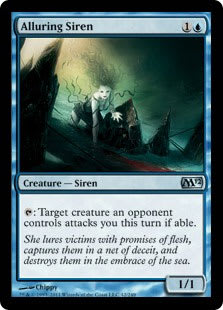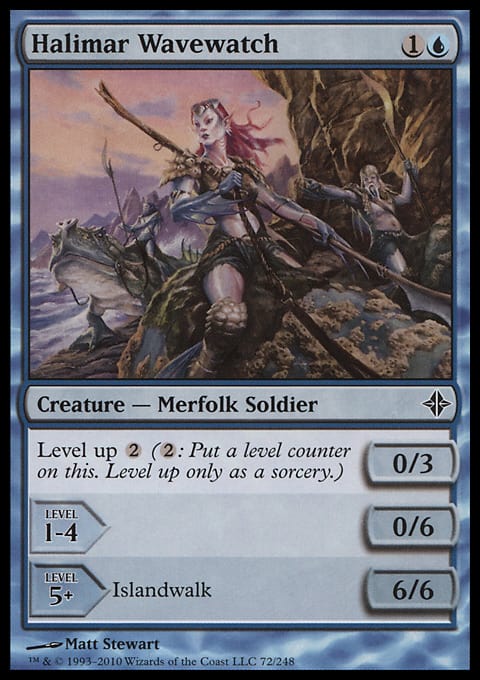The Merfolk are the iconic Blue tribe of creatures in Magic: The Gathering, and are back in the Standard format, returning to visibility at Friday Night Magic tables across the world. Ixalan's merfolk are familiar, yet different ; adding the color Green to their color identity. As I gathered notes for an art review of Rivals of Ixalan, I've come to need a Vorthos Art History to ask the question:
What Makes a Merfolk, Well, a Merfolk?
Surely the merfolk concept in Magic is based on mermaids, with references heavily based on the Atlantis myth by Plato, Hans Christian Andersen's the Little Mermaid, including the Disney cartoon, and the mythical figure Melusine. There were occasional reports of merman sightings, but those of mermaids were far more frequent in everything I found. The warrior culture mer-people was not a common theme, with nets or spears. While some cultures like Atlantis did have them, most stories were of the solitary half women, half fish.

Art by Boris Diodorov
Quick (near)Universal Themes
While researching merfolk, predominantly mermaids, I found they could be friendly and helpful, but their goodwill could not be taken for granted.
Ceta Disciple even shows the helpful nature of the merfolk with a perfect flavor text:
Other stories tell of terrible revenge taken by mermaids on those who harmed or offended them. I found pages upon pages of these examples and numerous Magic cards reinforce this concept.
Visually, mermaids were incorporated in the art on many water-themed historical items from pots to pitchers. They were used for signifying things as mundane as where a waterhole is to things as elite and abstract as heraldic crests. From tattoos, to etchings in scrimshaw, to depictions added to or carved into the bow of a ship, people connect merfolk to the sea. Whether it was a decorative motif or blessing, it was quite common in antiquity art.
It's assumed in our rational, scientific world that most mermaids were actually manatees, which apparently look human from a distance. A seal or sea lion could also be what sailors saw with graceful movements atop their boats, trying to find a myth from afar. The play of dim lights, and shadows off the water could have created illusions, helping hallucinations from sailors desperate for female companionship.

Via King Neptune, Silly Symphonies, Disney
With more time, I could've tracked down a short list of perfect sources, but for today, know that I found countless examples of a belief that every land creature had an equivalent in the sea. That's why seahorse, sea anemone, sea dog, sea wolf, and sea cow all exist. Merfolk were the human being example in water.

Before We Dive In, Let's Ask an Expert
Before I kicked off the article, I asked a few artists, "could you please offer up your armchair thoughts on what makes Magic's merfolk, well, merfolk, in your mind?"
 The unstoppable Howard Lyon was of course willing to offer his perspective:
The unstoppable Howard Lyon was of course willing to offer his perspective:
As far as what makes them merfolk, I think what makes the Magic incarnation different is that they are very firmly grounded in familiar elements. Extrapolated from human form, but then developed out with fish and sea elements that are also familiar. It creates a very believable race, that with some nudge of evolution could have been possible, at least in a fantasy laboratory.
Wizards has laid a good foundation for the merfolk with extensive concepts and give artists a whole eco-system of detail to draw upon. From the clothing and jewelry to the fins and skin color, it has all been well conceived to create a colorful and compelling race. They are very fun to paint because of all of the above and the palettes assigned to them are a blast to work with too.
After I read it I nodded, then wondered, what makes them so familiar?
Into the art history hole we need to go to find out why.

Storm Sculptor by Sidharth Chaturvedi (cropped)
Merfolk Around the World
 In studying what is and what isn't, looking to real world myth, especially in different cultures around the world, I wanted to provide some background information from concept pushes and set design. Then I had 60 pages and no one would read examples past the beautiful Lorwyn ones.
In studying what is and what isn't, looking to real world myth, especially in different cultures around the world, I wanted to provide some background information from concept pushes and set design. Then I had 60 pages and no one would read examples past the beautiful Lorwyn ones.
Instead I'm going to focus heavily on the more known tropes, as Magic defines merfolk as aquatic looking humanoids, full stop. Howard didn't dive into details and keeps the 20,000 foot strategic view that Magic can weave into sets.
To honor the intense amount of things to be explored I have links littered all over this article. Dig into them if you're curious!
Magic's version of shared mythical water folk of the past includes mermaids, sirens, Slavic rusalki, German nixies and water sprites. The visual variation is massive. Even the visual rules for Magic's merfolk tribe vary.
The following two artworks aren't even merfolk, yet in visual culture, a Sea Sprite and a Drowned Rusalka would be considered in the same folklore group. They share the same iconographic imagery as merfolk and mermaids, but aren't technically the same in modern fantasy and role playing games.
Let's take a quick trip through a few precedents of art history to see how Magic's merfolk build on past icons.
Babylon
The earliest representations of merpeople, that show creatures with a human torso and the tail of a fish, come from Babylon in the first millennium BCE. This is the start of the merfolk idea, at least in art that's readily available in multiple iterations across media. The god of the sea was Ea. He was also in charge of arts and sciences for the epic of their creation story along with covering wisdom for the Babylonians. Without going into too much depth, was depicted as his human form, shown below with sweet fish cape, or through symbols like the goat and fish.
To show how ingrained these symbols are in our culture, astrology still has him around. His symbols of goats and fish are fused into one creature, the capricorn. I found a few of those on coins, as Augustus Caesar liked them, in Rome's Musei Capitolini's coin museum in the basement.
 |  |
Magic currently has no goat/fish overlap, nor does it have merfolk interacting with goats at all. Though I fully approve of goats in ![]()
![]() merfolk decks. There are goat-headed minotaurs in Amonkhet, so there's hope yet.
merfolk decks. There are goat-headed minotaurs in Amonkhet, so there's hope yet.
Syria
 The earliest mermaid figure we'd recognize isn't far away. The ancient Syrian goddess Atargatis fit that role. Being popular from about 1000 BCE to about 500 BCE, she was their fertility god, akin to Aphrodite, along with being in charge of "general well-being" which is an odd catch-all term for health, wellness, and protection. Aphrodite's functions were likely based on Atargatis.
The earliest mermaid figure we'd recognize isn't far away. The ancient Syrian goddess Atargatis fit that role. Being popular from about 1000 BCE to about 500 BCE, she was their fertility god, akin to Aphrodite, along with being in charge of "general well-being" which is an odd catch-all term for health, wellness, and protection. Aphrodite's functions were likely based on Atargatis.
As you have overlap from Mediterranean gods to unified Greek to Roman, you see stories like Ovid in his Metamorphoses (5.331) telling of how Venus (Aphrodite) took the form of a fish to hide from Typhon. A coin from 95 BCE shows her depiction, showing cults able to withstand in Roman culture, yet combining when temples or stories were appropriated.
Greek
The Greek author Herodotus wrote about Borysthenis, the daughter of the Dnieper river god Borysthenes in the fifth century B.C.E. I've found one account claiming she had the torso of a woman and the tail of a serpent, though she isn't named consistently. The German translations of the Greek aren't great, so your mileage may vary.
Also of Greek origin are the naiads. While they aren't the traditional � woman, � fish of a mermaid, they're closer to the merfolk we experience in Magic. They were a subspecies of nymphs, the sentient embodiments of rivers, springs, lakes, pools and caves. Magic split them out in Theros, because it offered a Magic being some design space and was done incredibly well but carries the iconography of current Ixalan merfolk.
There's a significant Greek story about Hylas, a close friend of Hercules relating to mermaid.
In Apollonius Rhodius's Argonautica, the tale in the 3rd century BCE, while traveling with Jason and the argonauts, Hylas went looking for water one night and a naiad of the spring he found saw him. She fell infatuated in love with him, as one would. When he tried to have a drink of water, she placed an arm around him ready for a kiss, pulling him into the water. . Hercules searched so long, the Argonauts left him behind. Hylas was never seen again. This mermaid/siren/seductress/abductor idea in Magic mechanics has a longstanding trope to lean on.

Hylas and the Nymphs, John William Waterhouse, 1896
As long as we're on sirens, they were a type of naiad or sea nymph vs the river nymphs we've been examining and hold multiple cultural spaces in collective western art history.
Sirens lived south of Sirenum Scopuli, which is various locations, a rough and rocky island where they sang to sailors in the Mediterranean Sea. Of course the lured sailors would be drawn to the rocks, the ships would sink and the sailors would drown or be killed by the sirens. There were always at least two sirens in classical tales, with examples occurring until the late Renaissance. Homer's Odyssey uses wax to ignore their calls, which just makes sense.
Magic absolutely has used this classical myth extensively, with the "lure" ability moving away from merfolk proper, like in Fallen Empires, and moved to a separate creature class, Siren.
The Greeks also established that merfolk could have integrated fish anatomy from the waist down or have a lower half of a fish. Magic plays between both interpretations depending on a set's design and flavor needs. Magic has worked these angles.
For a non-western take on sea based feminine danger myths, in Malaysian folklore, a similar story is attached to Gua Langsuir, a cave located on the island of Pulau Dayang Bunting. Three female demons would sing so provocatively that sailors would drown trying to reach them. They could shapeshift into beautiful women as people came too close. Those sailors who were unfortunate enough to actually reach the female demons would then be tortured to death. One day, a deaf fisherman headed close to the island, as the song of these demons had no effect on him. The sirens were alarmed, thinking that humans had found a way to resist them. They fled and were never seen in mortal lands again. Whether or not there is a link between the Greek and Malaysian traditions has not been fully ascertained. In modern usage, an unknown or reluctant hero ignoring the siren's calls comes from youth, inexperience or ignorance of a greater threat. Magic has no analogue to merfolk or shutting down the islandwalk ability.
Roman
When I was just in Rome, I saw Gian Lorenzo Bernini's Triton Fountain. Imagine having an infect deck and being able to see an art historical reference of something that looks exactly Phyrexian. This is what I felt as I stood in front of the Italian master sculptor's masterpiece sculpture of merfolk. It was awe inspiring.
It's located outside a museum called National Gallery of Ancient Art in Barberini Palace and people can miss it. Along with it, I saw plenty of triton sculptures at the Musei Capitolini, continuing my merfolk experience that every Aether Vial user would appreciate. What I didn't know personally was what tritons looked like. They aren't like other mermaids.
They have a gill covering design, almost like stylized chest hair. Were this to be painted, I could see it standing out like a fish would. Ravnica would have those triangles likely be another color, brilliant and bold under armor.
To explain, from the height of Rome to today, they show merfolk in fountains almost constantly with few exceptions, like the four rivers allegory for example. Tritons were found on Theros and absolutely have an analog, though not as visually connected as the art historical example. They're also largely male, something that merfolk aren't often in myth, as fertility sculptures and objects were always female.
 |  |
Late Roman
In the late Roman Empire, or Holy Roman Empire, Melusine, the serpent woman, formed the basis of many literary tales of mermaids, became a product of medieval mythologies. Her story was absorbed into the folklore of Cyprus and reached Europe in the cultural exchanges that accompanied the crusades. She went by M�lusine or Melusina. It's mainly a French myth, and visually she doesn't transcend that much into contemporary culture other than when she is seen in her real form, horrible things would happen, but if you want to read deep on her, Pittsburgh professor D.L. Ashliman has a wonderful site on her. She's also the Starbucks logo, in case you're curious. She never left, she just became common folklore, able to be adapted and reused in new ways, like the Starbucks logo.
 |  |
Modern Era Mythical Mermaids
Jumping ahead a bit, let's touch on a few later representations that have found its way into gaming, like the Monstrorum Historia. The 1642 book by Ulisse Aldrovandi described both real and mythical creations. Merfolk were absolutely in there, shown below and in the margins of maps. The demon or humanoid faces depended on the region. Again, like the earlier myths of the sea having analogues to land based cultures, married couples and even religious figures like bishops were represented in watery versions of undersea communities They're lovely woodcuts, yet note the fins are arbitrary and not to scale or l based on actual fish reference.



Moving from Italy, I grew up in Germany, and I recall a localized myth that no question has comparables all over the world, so I figured I'd share.
Germany
This example of a merfolk siren is medieval German in origin. The name is shared with the giant hill near the city of St. Goarshausen. Lureln ley, or murmuring rock is the site where a dangerous siren would lure men to their deaths. The Lorelei was once a young woman betrayed by her lover. In grief, she jumped off a rock into the Rhine River unable to continue living. Instead of drowning, she was transformed, or born again, as a siren who lived atop the Lorelei rock outcropping. She would lure men, sailors usually, to the nearby cliffs, causing their boats to capsize and the men would ultimately drown. Heinrich Heine wrote a poem about the myth in the early 1800s and it has been a kitschy tourist destination ever since.

Unlike the naiads, the Lorelei was always solitary.
Moving to the final and most popular iteration, we move to Denmark.
Denmark
Much of the youthfulness and personal tragedy associated with modern mermaid depictions is from the original little mermaid which is, surprisingly not an ancient myth but a modern children's story.
Hans Christian Andersen's Faustian story "The Little Mermaid" is of Danish origin from 1837. Unlike the Disney version, the original is much different. The central theme is the same though, a female character takes charge of her destiny within a patriarchal world and falls in love with a sailor. She did have her tongue cut out and could dance, though her feet would be in excruciating pain when doing so. And also in the original, she dies in the end yet finds a way for salvation, without a man.
This is also where the definition of solitary mermaid is most often cited, despite previous citations. From sifting through sources, occasionally mermaids were seen in groups, but usually they were alone. This is not to suggest that the mermaids did not belong to a society. People generally thought of mermaids as living in underwater castles, which Disney also showed.
The story also made it hard to "leave" for the mermaid and they had to have someone to notice them, to seek them out. This doesn't fit the tribal lord, +1/+1 theme build into Magic's merfolk from Alpha and a clear divergence needed for gameplay, yet that basis is the most commonly thought identity for mermaids, the female version of a merfolk.

My Dad and I visiting the little mermaid in Copenhagen pic.twitter.com/H0ETZzpslD
— ?Aaron Miller GP London (@aarondraws) January 23, 2018
United Kingdom
Unlike mermaids, the UK has a radically different myth. The wereseals, also called silkies or selkies, are fairly common in the folklore of regions. From the Shetland Islands and the Mermaid wife, to the silkie wife of the Orkney Islands, the stories are pretty plentiful. Again, Ashliman provides a good starter resource.
In short, the myths are about a husband finding out his wife is actually a seal, or selkie. Like Melusina, once she is seen, the woman would flee or have calamities occur. The slightly darker feeling of the mermaids was less Denmark and more horror/demon mix.

Magic used this mythology in existing design. They provided a great Celtic shift for the Lorwyn to Shadowmoor move from light to darkness, and from partial merfolk to full merfolk. Those designs were novel, unique and allowed for Green merfolk to exist eventually in Ixalan.

The concept art team used the merfolk idea still, but since the merfolk became more fish like in facial features, they balanced that with another merfolk that was humanoid, the selkie.
 |  |
We see the finalized products as entirely fish vs. sea lion mixed with human. They're both merfolk, and yet one has a new culture represented, which can make the Lorwyn/Shadowmoor blocks feel so radically different because they are lesser known tropes.
Now that you know the cultural depth of merfolk, next time we will see how MTG design and artists work to bring us the menfolks as we know then now.
Next time, we'll look at how Magic went from mermaid basis, to this:

Deeproot Champion by Alex Konstad (promo)
-Mike








































